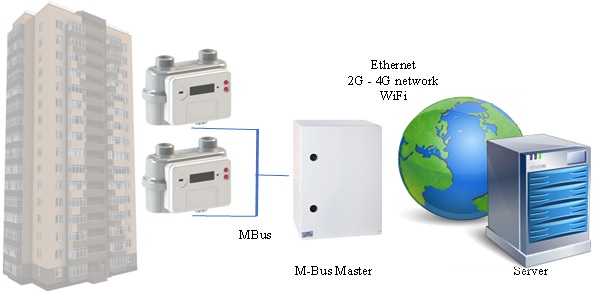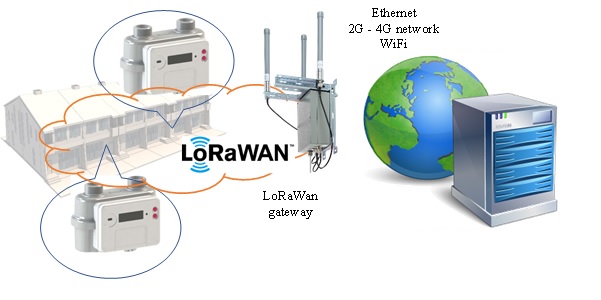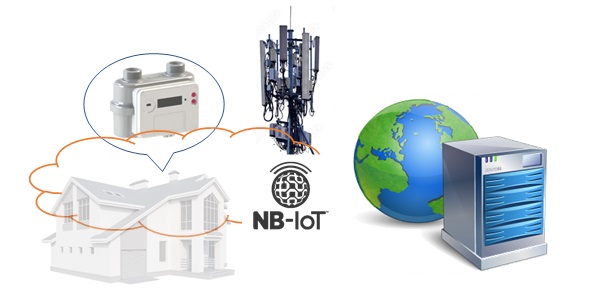Gas consumption monitoring system
In the context of rising energy prices and the need to improve energy efficiency in housing and utilities, the implementation of gas consumption monitoring systems is becoming especially relevant. Such solutions not only ensure transparency of accounting, but also optimize costs, increase safety and improve service to end consumers.
The implementation of systems with support for prepaid services and the function of remote gas supply shutdown is becoming especially relevant. Such solutions allow not only to increase the efficiency of resource management, but also to minimize debts, improve safety and ensure fair distribution of costs.
What is a monitoring system?
The gas consumption monitoring system is a complex of hardware and software tools that provide automated collection, transmission, storage and analysis of data on gas consumption in residential and communal facilities.
The system allows the consumer to pay for gas in advance and use it within the paid volume. In case of non-payment, the system automatically shuts off the gas supply, ensuring strict control and preventing losses for suppliers.
Main components of the system
- Gas meters with valve control module – measure the flow rate and automatically shut off the supply if necessary;
- Electromagnetic or ball shut-off valve, built into the meter or installed separately;
- Controller or modem (M-Bus, NB-IoT, LoRaWAN, GSM) — provides remote data transmission and control;
- Software platform — for accounting of payments, balance replenishment, consumption analysis and meter status management;
- User interface — a mobile application or personal account through which subscribers can monitor their balance and pay for services.
Benefits of implementation
- Accurate and timely accounting. Automatic data collection eliminates manual input errors and ensures high measurement accuracy.
- Cost reduction. By promptly identifying leaks, overconsumption or unauthorized connections, it is possible to significantly reduce gas losses and maintenance costs..
- Increased transparency. Management companies and residents gain access to data in real time, eliminating disputes over charges and allowing them to better control their own consumption.
- Increased security. Modern systems can promptly report emergency situations: gas leaks, pressure drops, attempts to break in or interfere with equipment.
- Automation of reporting and analytics. The system generates reports, forecasts consumption, analyzes seasonal and daily fluctuations.
- Financial discipline. The consumer cannot accumulate debt - gas is supplied only upon payment. This protects the interests of the supplier.
- Reduction of accounts receivable. Management companies and gas supply organizations are freed from the need to collect debts and perform manual disconnections.
- Convenience for residents. Payment is made at any time online, with the ability to top up the account as needed, similar to mobile communications.
- Security. In case of detection of a leak or other abnormal situations, automatic blocking of gas supply is possible.
- Flexible management. The supplier has the ability to remotely turn on or off the gas supply, carry out preventive maintenance and diagnostics of the equipment.
Data transmission technologies
Modern solutions use various communication technologies:
- NB-IoT — an energy-efficient protocol that operates in 4G mobile networks, providing wide coverage;
- LoRaWAN — long-range radio communication, convenient for objects without cellular communication;
- Wi-Fi/GSM/3G/4G — traditional protocols for urban environments;
- Wired interfaces (RS-485, M-Bus) — more often used in multi-storey buildings and industrial facilities.
Typical scenarios for using a gas consumption monitoring system
1. Apartment building

Features:
- High subscriber density, capacity of one system zone up to 1000 devices.;
- Availability of technical rooms (basement, control room);
- Often the wired infrastructure is already in place (or is easy to install).
Recommended technology:
- M-Bus (wired);
- NB-IoT for partial wireless implementation.
Architecture:
- M-Bus meters with electromagnetic valve are installed;
- All meters are connected to a centralized controller (M-Bus Master);
- The controller is connected to the Internet (via 3G/4G, Ethernet);
- Prepaid balance is stored on the server, the system controls the valve;
- Alternative: Use NB-IoT meters if wiring is not possible.
Advantages:
- Centralized management;
- High reliability;
2. Cottage village, townhouse

Features:
- Distributed structure of objects;
- Relatively small distance between houses (100–500 m);
- There is often no cellular coverage in the desired area.
Recommended technology: LoRaWAN
Architecture:
- Each house is equipped with a smart gas meter with a valve and a LoRaWAN modem;
- LoRaWAN gateways are installed (1–3 pcs. cover the entire village);
- Gateways connect to a cloud server (via Ethernet or 2/4G);
- The platform monitors balance, controls valves;
- Personal account and mobile application for residents.
Advantages:
- Does not require payment for cellular communication for each meter;
- Works well in enclosed or private areas;
- Remote gas shutdown in case of non-payment or accident.
3. Detached house or cottage

Features:
- One consumer;
- There is often no centralized access to the Internet;
- Can be located in a remote area.
Recommended technology:
- NB-IoT — best choice (built-in modem, autonomy);
- LoRaWAN — if there is already a gateway in the area (for example, from another project);
Architecture:
- Installation of a gas meter with NB-IoT and a shut-off valve;
- The meter automatically transmits data to the operator’s cloud;
- Balance and valve control via internet;
- The user can top up the balance through the website or mobile application.
Advantages:
- Complete autonomy;
- No local infrastructure required;
- Installation is possible "in the field" - only a meter and a SIM card.
Comparison table by scenarios
|
Characteristic
|
Apartment building
|
Cottage village
|
Detached house/cottage
|
|
Optimal technology
|
M-Bus / NB-IoT
|
LoRaWAN / NB-IoT
|
NB-IoT
|
|
The need for a gateway
|
Yes (1 M-Bus Master)
|
Yes (1–3 gateways)
|
No
|
|
Power supply
|
From grid
|
Battery life 10 years
|
Battery life 10 years
|
|
Centralized management
|
Yes
|
Yes
|
No (independent)
Yes (within the framework of the accounting system)
|
|
Possibility of prepayment
|
Yes
|
Yes
|
Yes
|
|
Remote shutdown
|
Yes
|
Yes
|
Yes
|
|
Cost of implementation
|
Medium
|
Medium/high
|
Low
|
Software platform and user interface
Software platform (server part)
The central component of the entire system is a cloud or local software platform that receives, processes, stores and visualizes data, and also controls devices (for example, turns off the gas supply when the balance is zero).
Key features of the platform:
- Receiving data from metering devices (via NB-IoT, LoRaWAN, via gateways or via M-Bus Master);
- Storage of data on consumption, balance, events and assets (meters, subscribers);
- Device management: sending commands to turn on/off gas, restart, configuration;
- Billing and prepayment: maintaining personal accounts of subscribers, calculating expenses, notifications about balance end;
- Analytics and reporting: consumption by periods, subscriber comparison, leakage control;
- Notifications: automatic notifications about events (disconnections, zero balance, alarms);
- Integration with ERP/GIS Housing and Public Utilities/1C: via API and standard protocols (REST, MQTT, OPC UA ...).
The platform can be:
- Cloud (SaaS);
- Installed on the server of the management organization (on-premises);
- With support for secure communication channels (VPN, HTTPS, TLS).
User interface
The system includes two types of user interfaces: administrator and subscriber..
Interface for management company/operator
- Web panel with display of all objects on the map;
- Lists of all subscribers, devices, their status and balance;
- Ability to send commands (disconnection, connect, request data);
- Monitoring events (leaks, malfunctions, late payments);
- Import/export of data, integration with payment systems and GIS Housing and Public Utilities.
Interface for the subscriber (resident)
Access via mobile app or personal account on the website:
- View current balance;
- Gas consumption charts;
- End of balance notifications;
- Online payment (cards, QR, auto payments);
- Payment and accrual history;
- Setting up a profile, notifications, auto-disconnections.
The application can be implemented as a native (iOS/Android) or as a PWA (installation via browser).
Conclusion
The introduction of a gas consumption monitoring system in housing and communal services is not just a step towards digitalization, but also a real opportunity to improve the economic and environmental efficiency of utilities. Such technologies become the basis for creating "smart homes" and "smart cities", where resources are spent wisely, and management becomes transparent and efficient.


 PRODUCTS AND SOLUTIONS
PRODUCTS AND SOLUTIONS